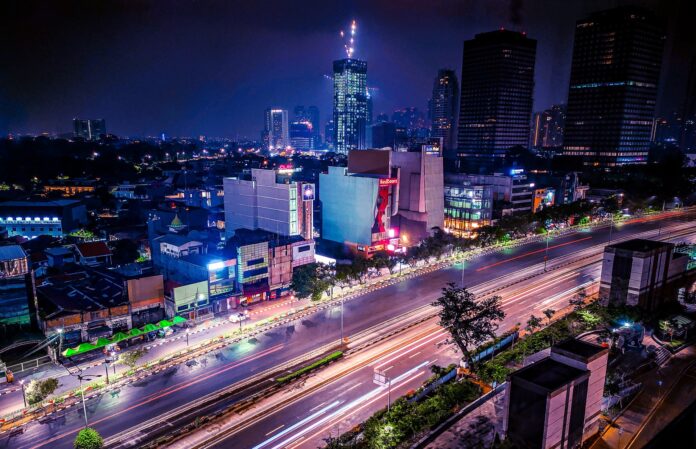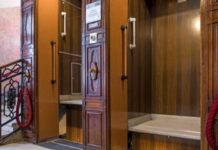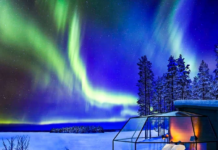Now it’s in the news. The Indonesian government first announced its intention to move the state capital back in 2019. And at present, it has been voted on by parliament: so, the new city of Numasantara will be built on the island of Borneo. In that big island, which stands divided between Indonesia, Malaysia and Brunei. The name of the future capital means ‘archipelago’, in local language. An iconic way to represent this endless state made up of 2500 inhabited and 15000 uninhabited islands.
Before starting work, however, the government wants to complete the vaccination plan. In short, before 2024 (at least) this new ideal city will not see the light. To be continued.
The doomed fate of Jakarta
# Why is the Indonesian capital being relocated?

But what drives a country to invest an endless number of resources to move the ministries to another island thousands of kilometers away?
The official reason is that Jakarta sinks at an average of about 7.5 centimetres per year, due to subsidence and rising seas. And if global warming is a world problem, the overcrowding of the capital located on the island of Java is an entirely local issue. 10 million inhabitants, environmental pollution and car traffic place the city at the top of the world negative rankings.
Environmentally speaking, however, the transfer of capital will bring new problems: the deforestation of tropical areas of Borneo, endangering biodiversity. Will they have weighed the pros and cons of such a move well? It seems so, and that the dam under construction to save Jakarta will not be enough in the long run: the city could have serious survival problems by 2050.
# J-Town, the sinking city

The change of capital city is not a new custom in Southeast Asia (think of the relatively recent cases of Putrajaya, Malaysia and Naypyidaw, Myanmar). But in this case it is the first time that such a choice has been made in conditions of threat to the present capital. Yet at the moment as many as 96% of the local population has spoken out against the transfer of power. It’s evident in the citizens of Jakarta the awareness of the induced wealth that generates the presence of so many government offices.
Inhabitants nickname Jakarta as the Big Durian, with reference to the famous smelly green national fruit. In reality, even if it cannot rival other metropolises in the area such as Bangkok or Singapore, Jakarta is certainly worth a visit. Perhaps at the beginning of a tour that will later take you to visit the wonders of the whole country. Let’s go there, then, before the sea level submerges it.
# The irresistible charm of the agglomeration

If you like large urban centers, your heart will beat fast here too. Let’s start by saying that the first impression on the city, discounting its already known negative limits, is more than positive. We are struck by the systematic trees of the streets, always messy and fascinating, giving the city a profound meaning of urban jungle. Even the average level of services is above our expectations. Just think about the resource of TransJakarta, the largest Bus Rapid Transit (BRT) system in the world.
The numerous skyscrapers, some dated, others still under construction, also give Jakarta the nocturnal charm of contemporary cities. Of course, the city is endless and getting from one side to the other by taxi invariably takes at least an hour. Permanent traffic jams are the norm, slowly moving in front of the many warung, the street food shops.
# Looking for the old Batavia

The old Dutch colonial center of the former capital of the Dutch East Indies (Batavia) can no longer be considered the hub of the city. Indeed, the city has moved its main activities to the south. Still, it remains the oldest and most pleasant area to walk around. Today it is called Kota Tua and runs around Fatahillah Square, a lively square where traditional dance performances take place regularly.
Here you will find the Jakarta History Museum housed in a Dutch-era building, with paintings and antiques. On top, you could take a tour inside the Wayang Museum, which exhibits Javanese wooden puppets. And last but not least, you will find here the local girls. Most of them are veiled, and all of them are searching for the inevitable selfie with the puppets of Doraemon or Masha & the Bear.
Nearby from here, schooners and fishing boats ply the old port of Sunda Kelapa. You can go there with a cheap tuk-tuk or by renting the colorful bicycles equipped with protective hats. In the old port, among the white boats decorated with traditional colorful motifs of the local folklore, you can observe live the activities of loading and unloading goods. In the former warehouses beside, you can go back in time by visiting the collections of the Maritime Museum.
# When movies are an inspiration

What does this Indonesia tell us at first sight? Society is undoubtedly in a clash between a fringe of extremist Islamists and some youngsters who want to live as in the West. Local cinema tells us so. And it does that with class: let’s just think about the saga of The Raid, well-made horror films. The second one was shot in the iconic Plaza Indonesia shopping center, located in the affluent Menteng district. More recent Netflix film Photocopier, which clearly reflects the level of corruption in the country, was also based here. In general, the Indonesian population is such an extreme mix that the country maintains a certain basic tolerance for all minorities. This is done through a glue language without grammar that also has several borrowings from Romance languages.
# Jakarta not to be missed

We left the most well-known monuments at last. No worries, we all know very well that no visit, not even the most alternative one, can be such without them. At the center of it all is the MoNas (short for Monumen Nasional), the city’s most emblematic monument. It was erected in 1961 to commemorate those who fought against the Netherlands for the country’s independence. Walking along the vast, boxy Merdeka Square, you will note as well the Presidential Palace, where Widodo currently resides. The actual president is in office since 2014. Then you can visit the interior of the Indonesian National Museum, which stands out both for the beauty of its building and for the beautiful elephant fountain.
In front of each other, you can find the two most important religious buildings in Jakarta. We are speaking of the Neo-Gothic Cathedral of Our Lady of the Assumption (1901) and of the famous Istiqlal Mosque (1978 ), the third largest Sunni mosque in the world. Okay, now go and eat some seafood, before the ocean becomes master of everything. I don’t know if you have seen Don’t Look Up, but it is probably time to drink like there is no tomorrow, in the tourist spots of Jalan Jaksa’s unpretentious cocktails. Let’s then toast to the tomorrow of this extraordinary city, maybe it will be better than it is foreseen.












